Fathom Consulting and the European Climate Foundation (ECF) were delighted to bring together policymakers, businesses and other stakeholders to preview and discuss the findings of our new research on the economics of decarbonising European aviation. The event was held at the Thon EU hotel in Brussels on 8 April 2025.
![]()
Brian Davidson
Head of Energy & Climate
Fathom’s study, supported by the ECF, uses model-driven analysis to consider how to decarbonise European aviation in the most economically efficient way possible. These findings were considered and presented in the context of Europe’s wider policy objectives, such as boosting economic competitiveness and enhancing energy security through the Clean Industrial Deal and Sustainable Transport Investment Plan.
The event was framed by an insightful introduction from James Wood, Aviation Lead at the European Climate Foundation, who highlighted the uncertain future of aviation and the need for coordinated action. He stressed that the European Climate Foundation’s commissioning of Fathom’s research is an important step in navigating the intersection of economics, geopolitics, and finance. Despite global uncertainties, the net-zero transition’s core principles remain: reducing fossil fuel reliance, investing in renewable energy, and ensuring leadership from businesses and policymakers.
Fathom’s unique approach quantifies the costs and benefits of different types of sustainable aviation fuels (SAF) and zero-emission flight (ZEF), and assesses how they change over time, under different scenarios and at different levels of decarbonisation. In most scenarios, we find that ZEF becomes the cheapest form of low carbon flying at higher levels of decarbonisation. In most scenarios, we find that ZEF becomes the cheapest form of low-carbon flying at higher levels of decarbonisation. At the same time, there are suggestions that the industry is reducing the role it sees ZEF playing in the decarbonisation mix by 2050. We discussed possible reasons for this disconnect, and steps that policymakers could take to address it.
We asked the audience for their views. Using a poll, the audience was asked to share their thoughts on why the industry expects ZEF to have a reduced role by 2050. They were presented with several possible reasons and asked to vote for the three they believed were most relevant.
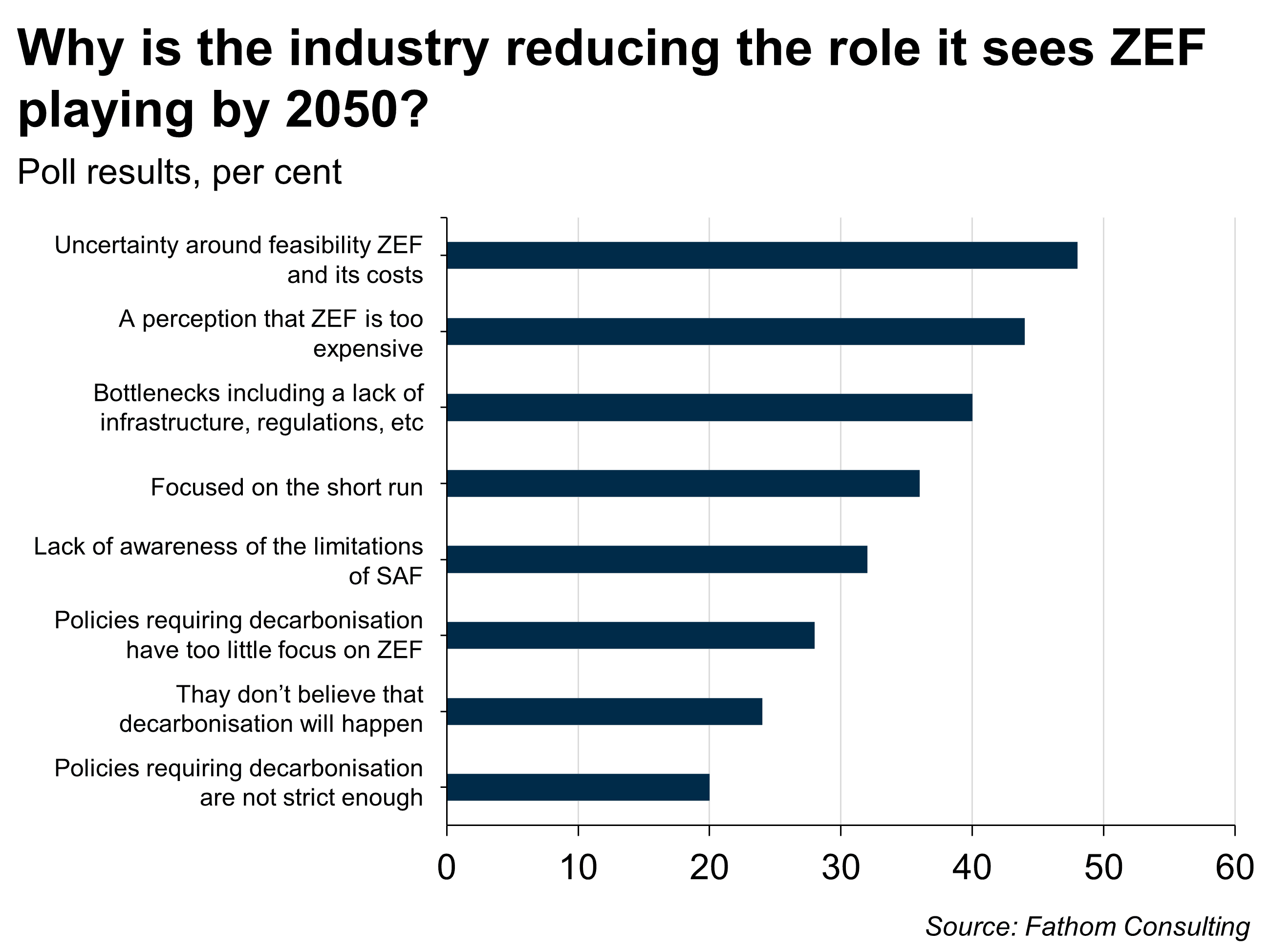
Interestingly, the top three answers highlighted the uncertainties around the feasibility of ZEF, its costs and the infrastructure needed to support it. In the panel discussion, Victor Vareille, from ZeroAvia, expressed an optimism that consumers witnessing ZEF planes in the sky, even if for very short distances and small payloads, would be a powerful signal to demonstrate the feasibility of this technology and remove some of this uncertainty. He also highlighted his company’s belief that this will happen in the next few years.
Our analysis highlighted the feedstock limitations of waste-based SAFs, and how this would cause the prices of these SAFs to rise considerably at relatively low levels of decarbonisation. One attendee noted how the electrification of road transport could unlock more feedstock to make SAF. Another noted how recent advances in battery technologies could enable battery electric aircraft to fly further distances than the 500km that our analysis assumes. We recognise these possibilities, although they do not fundamentally change our conclusions — that pinning all hopes on SAFs is a risky bet, and that ZEF should play a key part in the long-term decarbonisation mix.
We recognise that there is a lot of uncertainty around the outlook for the costs of different SAFs and ZEF, not least due to the price and availability of renewable electricity and CO2. Moreover, as with any emerging technology, there will always be uncertainty about the outlook for that technology and possible disruption to it from other technologies. But we also highlighted that this should not be a reason for the sort of inaction that has led Europe to fall behind China in other decarbonisation technologies, including solar, batteries and electric vehicles.
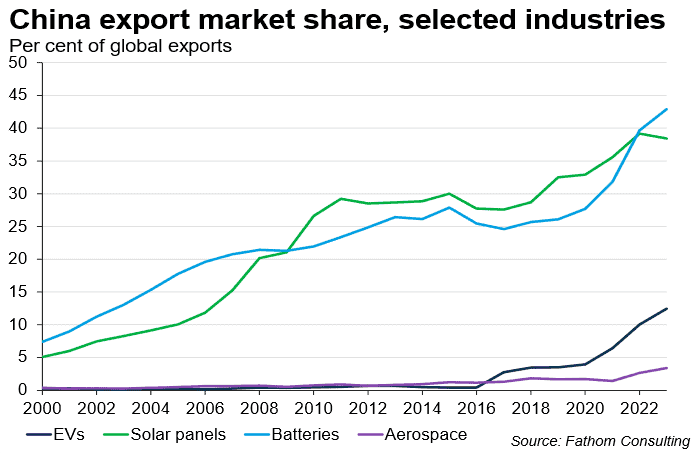
Several attendees told us how most studies in the field of aviation decarbonisation are focused on SAFs and that our work was refreshing because it highlighted some of the limitations of SAFs and opportunities for ZEF. Overall, our analysis was well received by the attendees, and we received compliments on the originality of our work and our demonstration of these issues clearly using data visualisation tools.
Our model compares the levelised costs of the available decarbonisation options at different levels of decarbonisation under a range of scenarios. Levelised costs allow for a direct comparison between different technologies on a like-for-like basis, where capital costs are spread over their useful life — meaning that the cost per unit of output (in this case MWh used to power a plane) of capital-intensive technologies (ZEF, and to a lesser extent PtL) can be compared to those where operating costs are a larger share of overall costs (HEFA and FT).[1]
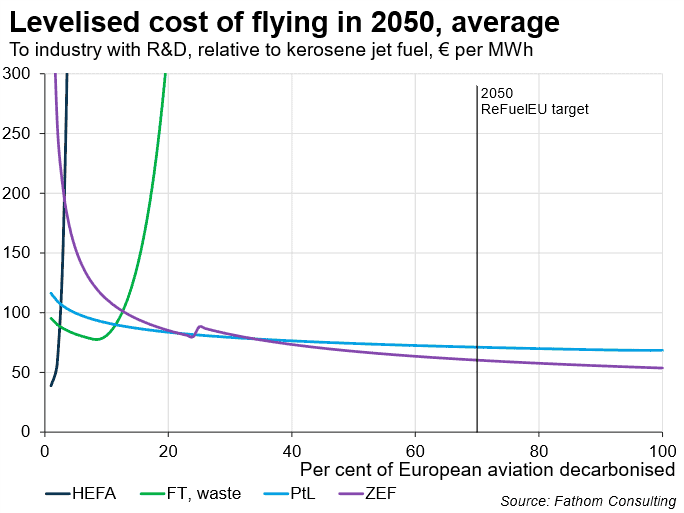
The chart above shows the average levelised costs of four different decarbonisation options at different levels of decarbonisation in 2050. The horizontal axis illustrates the per cent of European aviation decarbonised, while the vertical axis is the cost of the decarbonisation technology over the cost of flying using kerosene in euros per MWh. Our presentation contained several iterations of this chart. It shows that:
- The costs of ZEF are very high at low levels of decarbonisation. This is because significant R&D costs would be incurred to enable this technology, and they would be spread over relatively few flights. The costs come down at higher levels of decarbonisation, since the R&D costs are spread over more flights and since the costs of building new planes and infrastructure decline as more gets built, thanks to learning by doing and economies of scale.
- The cost of PtL falls at higher levels of decarbonisation for similar reasons, although it is less R&D- and capex-intensive than ZEF.
- The costs of HEFA and FT start lower and rise as more decarbonisation gets done and feedstock is used up.
We warned that too much focus on the short term will lead to decisions that prioritise decarbonisation methods that are not truly sustainable and where costs will spiral in future. We drew attention to the risks attached to ignoring solutions that are expensive at low rates of decarbonisation but where the costs fall as decarbonisation of aviation approaches 100%. While these are model-driven results, we find that this set of conclusions holds in most scenarios, provided there is sufficient clean electricity and CO2 to make hydrogen and PtL fuel in future. The central set of assumptions used in this illustration are detailed below.
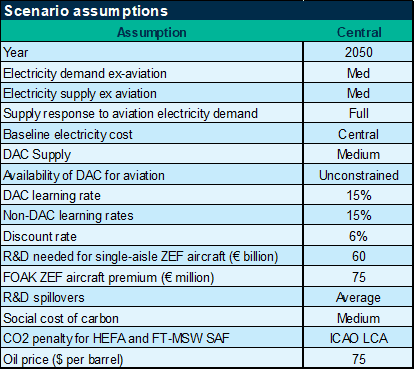
The context for this research is Europe’s urgent need to improve economic competitiveness. This need has been given extra impetus by reports by the likes of Mario Draghi and Enrico Letta; ensuring that competitiveness sits alongside decarbonisation is therefore a key part of policies such as the Clean Industrial Deal. While there are several reasons that Europe’s productivity has lagged, we drew attention to lower R&D spending in Europe as a share of its GDP.
We explained why European governments should support cutting-edge R&D, such as aviation decarbonisation technologies and ZEF in particular: difficult R&D typically has larger economic spillover benefits and, since Europe is an aviation leader, protecting and boosting the market share of its aircraft manufacturers and broader aerospace supply chains would have significant economic benefits. When these economic spillover benefits are taken into account, from society’s point of view it would be cheaper to fly using ZEF than kerosene. We also explained that because those typically doing the R&D do not accrue all or even most of the benefits themselves, the private sector will do less R&D than is optimal for society.
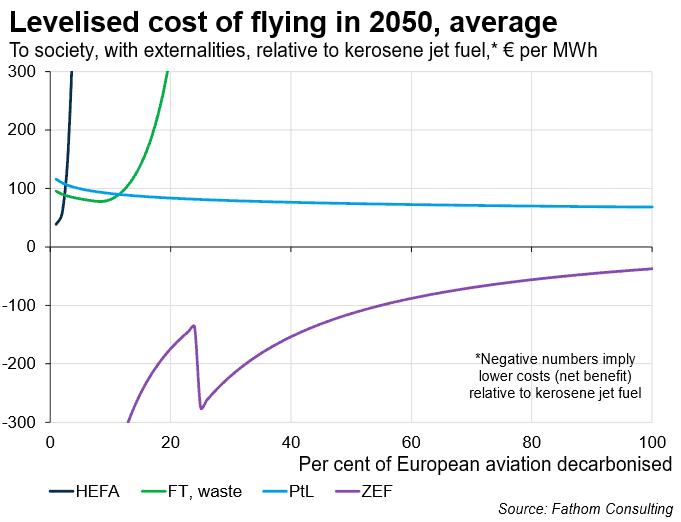
There was a lot of discussion about how to pay for decarbonisation and how to encourage the industry to invest in ZEF technologies and the supporting infrastructure to allow its widespread adoption. Beata Kušová, an Aviation Policy Officer in the Directorate-General for Climate Action, European Commission, noted how policymakers were keenly aware of this technology and its potential, but needed to see more progress on the technology before tangible policies such as ZEF mandates were introduced. Similarly, Alexandros Ouzounopoulos, Sustainability Manager at ACI Europe, noted how airports were very aware of ZEF and its potential, but that numerous steps would need to be taken, including new testing and certification, in addition to the extra infrastructure that would be needed.
The audience was asked what actions the industry should take now if ZEF is the long-term solution, given the time needed to develop the necessary technologies, infrastructure, and aircraft. They were asked to choose one of four strategic priorities, focusing on how to balance SAF and ZEF across short-haul and long-haul segments.
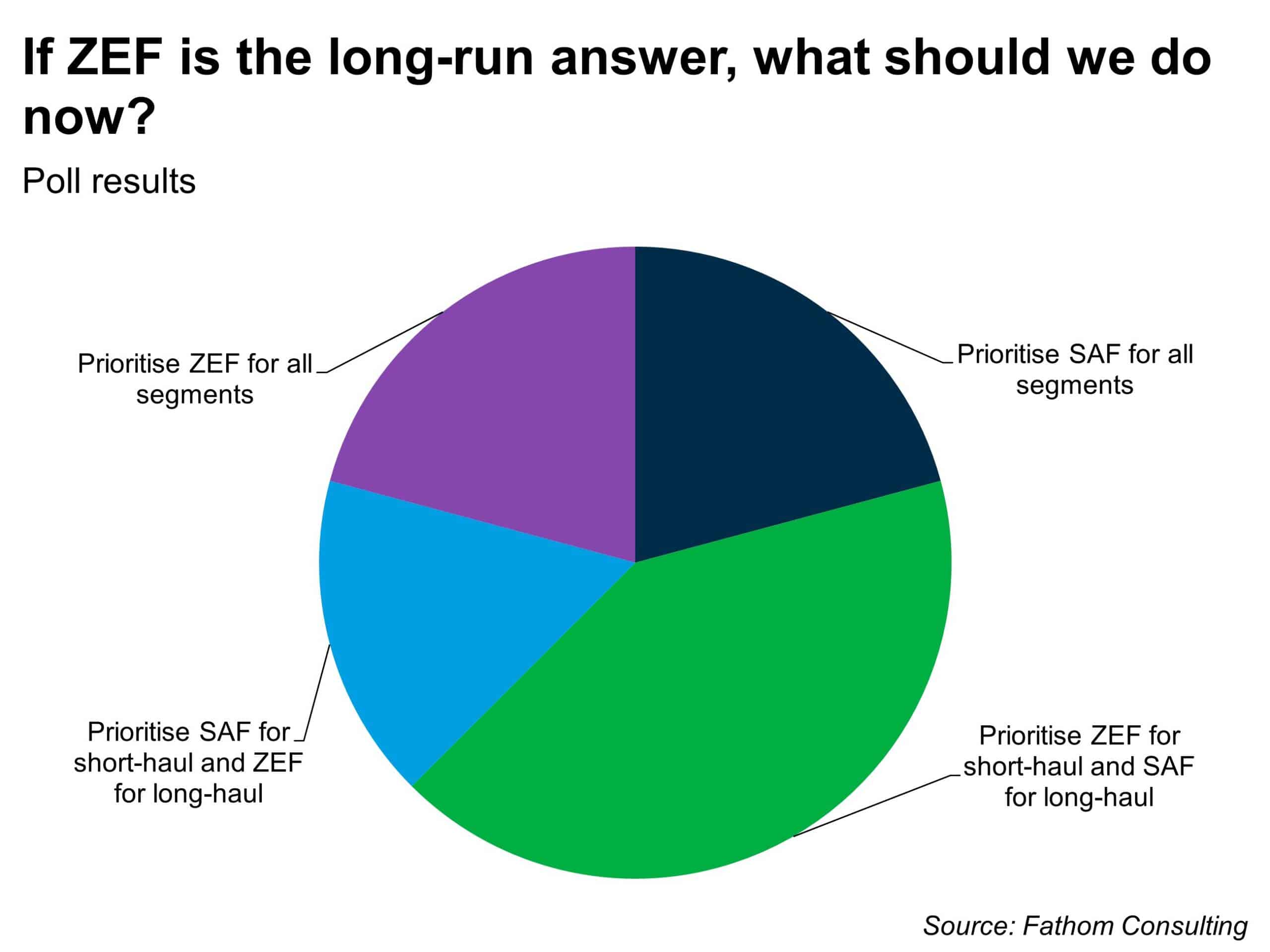
The results reflected a strong preference for a hybrid strategy, with 42% of respondents voting to focus on ZEF for short-haul flights and SAF for long-haul. This suggests growing awareness of the different challenges and timelines involved across flight segments.
The audience was then asked what actions policymakers should take, based on our findings. They were given a list of possible policy measures and asked to select the three they felt were most important.
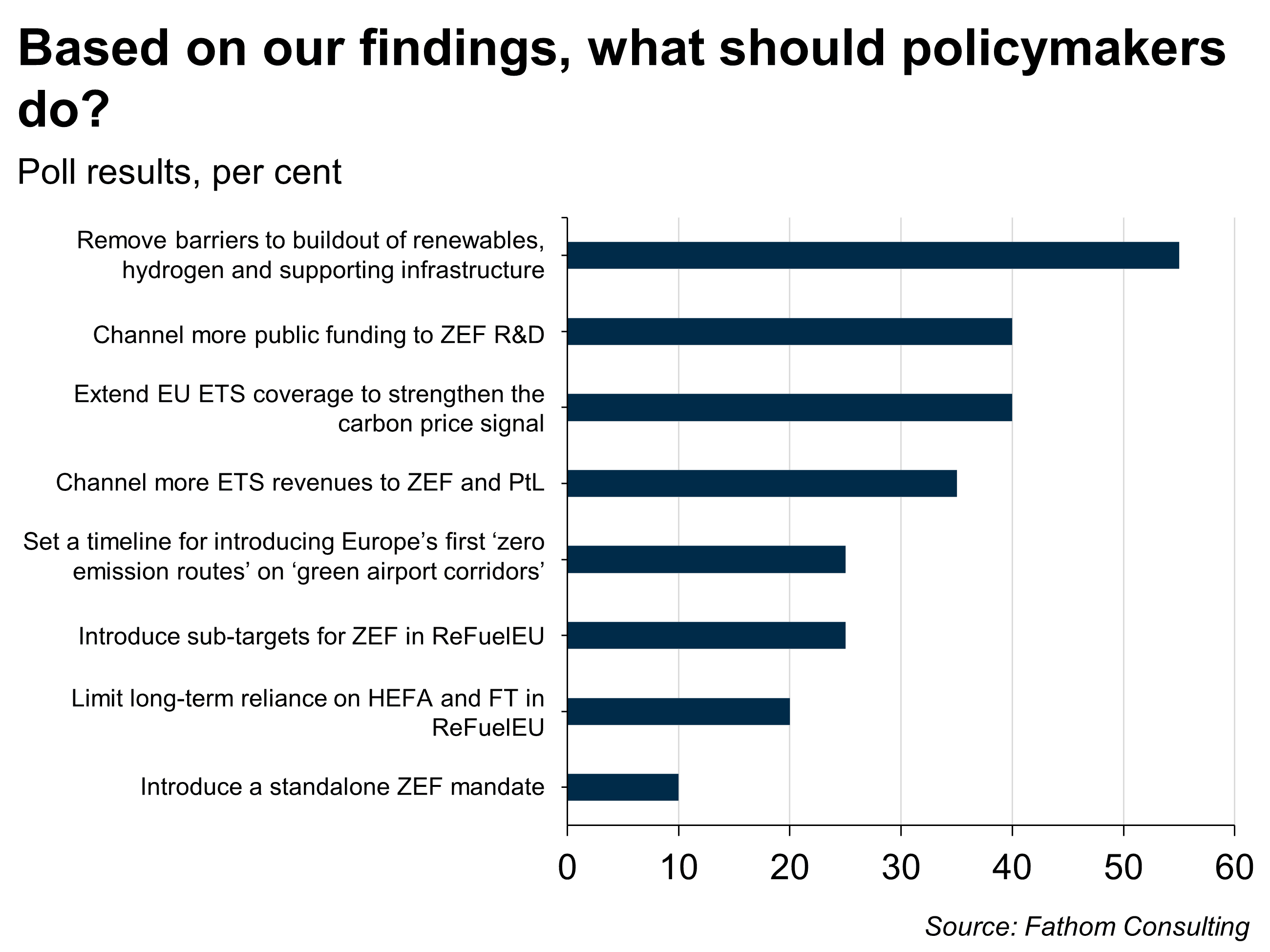
The top priorities were removing barriers to infrastructure rollout (55%), extending the EU ETS (40%), and increasing public funding for ZEF R&D (40%). Overall, the audience favoured enabling policies that support progress, rather than new regulatory mandates.
The panel of experts discussed key questions on global competition, policy frameworks, and the necessary actions to drive change. Beata Kušová focused on the European Commission’s strategies, like the EU ETS and ReFuelEU, while Aoife O’Leary emphasised the importance of aligning aviation and maritime efforts on sustainable fuels and zero-emission technologies. Victor Vareille tackled the challenges of hydrogen adoption and geopolitical tensions, and Alexandros Ouzounopoulos emphasised the critical role of airports in supporting the clean aviation transition. Overall, the panel stressed the need for coordinated policies and investment to ensure Europe’s competitiveness in clean aviation.
At the close of the event, each panellist was asked this question: “If you were granted one wish to make any change in the clean aviation transition, what would it be?”
- Alexandros Ouzounopoulos, Sustainability Manager, Airports Council International Europe, requested two wishes: a dedicated aviation strategy for Europe, similar to those in other sectors, and continued EU support for aviation decarbonisation amid geopolitical uncertainties.
- Aoife O’Leary, Director of SASHA Coalition & CEO of Opportunity Green, wished for the extension of the EU Emissions Trading System (ETS) to international aviation and more cohesive EU policies aligning decarbonisation across aviation, shipping, and biodiversity targets.
- Victor Vareille, Strategy Director, ZeroAvia, wished to fast-forward two years, seeing hydrogen-powered aircraft flying commercially. He stressed that the technology is already feasible, and that simplifying certification would speed up the transition.
- Beata Kušová, Aviation Policy Officer, European Commission, wished for effective fossil fuel taxation and immediate action to address the ‘chicken-and-egg’ problem, urging everyone to move past the analogy and take concrete steps instead of waiting for ideal conditions.
- Erik Britton, Fathom CEO and managing director, wished for decisive EU action, urging Europe to utilise existing resources in order to lead the way in clean aviation technology development in the face of global competition.
The event closed with a clear message: while decarbonising aviation presents significant challenges, it also brings valuable opportunities, provided we act decisively. Discussions throughout the day emphasised the critical need for coordinated action across policy, industry, and infrastructure. There is growing support for ZEF and a strong call for more robust policy signals and investment frameworks to drive the transition. Our analysis confirms that ZEF can play a pivotal role in long-term decarbonisation, but only if the groundwork is laid now. We look forward to sharing more insights in our full report this June.
[1] For ZEF, the levelised R&D costs associated with the technology are assumed all to occur before the first per cent of decarbonisation is done using ZEF. Similarly, for ZEF to be used for long-haul flights, an additional amount of R&D must be done before using ZEF for long haul begins. Unlike other costs, R&D cannot be scaled up as more of aviation is decarbonised, rather it is a pre-requisite to any aviation decarbonisation using ZEF.
Explore more:
View images from the event here: Brussels event image gallery
Read about our project including key milestones, webinars and in-person events. This page will be kept up to date with the final report once it is published. View here and sign up to receive updates: Decarbonising European aviation page.
Fathom is a world-leading consultancy specialising in the global economy, geopolitics and financial markets. One of our core focuses is climate-related research. We provide clear analysis and advice on the energy transition, and the economics of climate change, to assist policymakers, strategists and investors.
The European Climate Foundation (ECF) is a major philanthropic initiative working to help tackle the climate crisis by fostering the transition to a net-zero emission society at the national, European and global level. It supports over 700 partner organisations to carry out activities that drive urgent and ambitious policy in support of the objectives of the Paris Agreement, contribute to the public debate on climate action and help deliver a socially responsible transition to a net-zero economy and sustainable society in Europe and around the world.